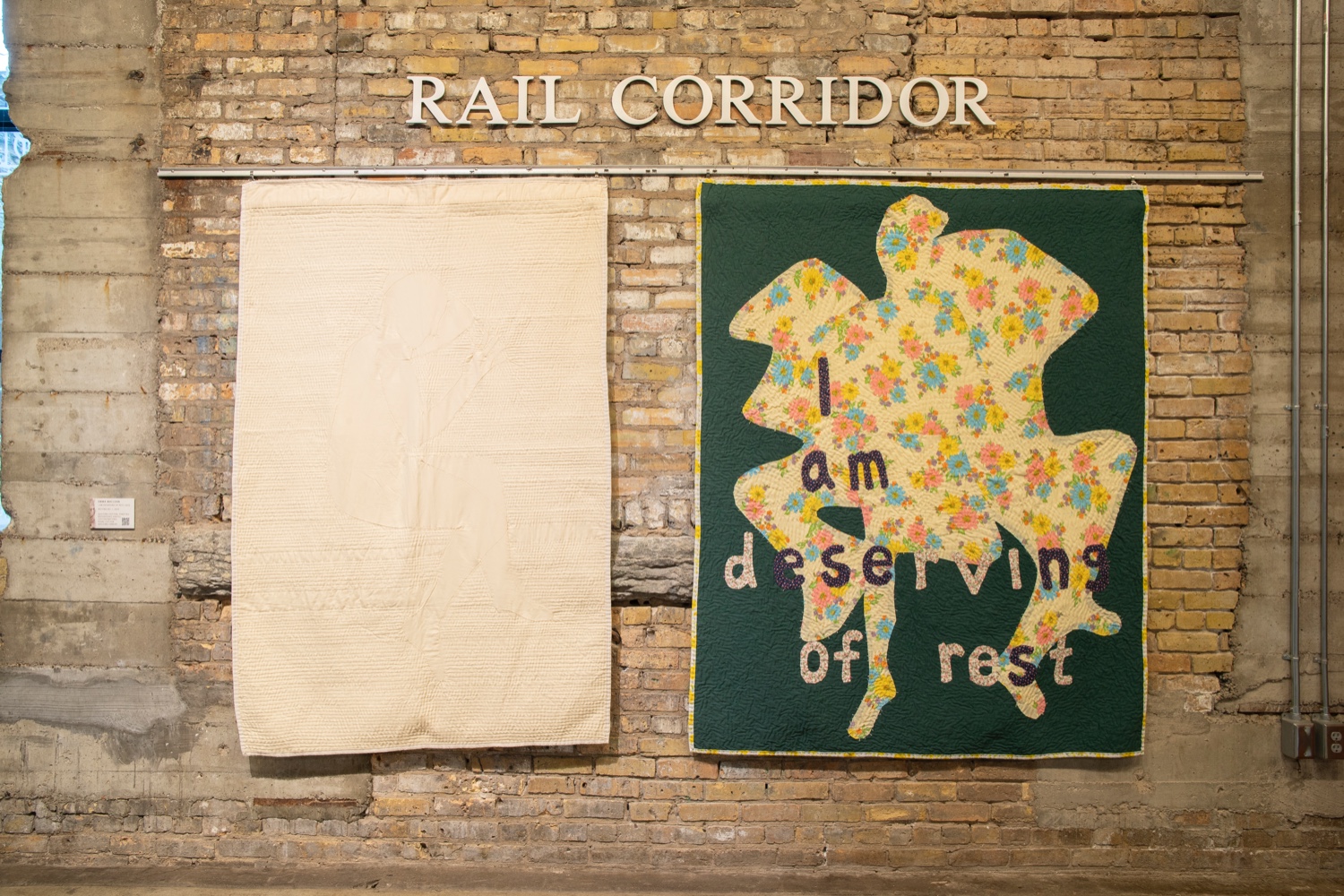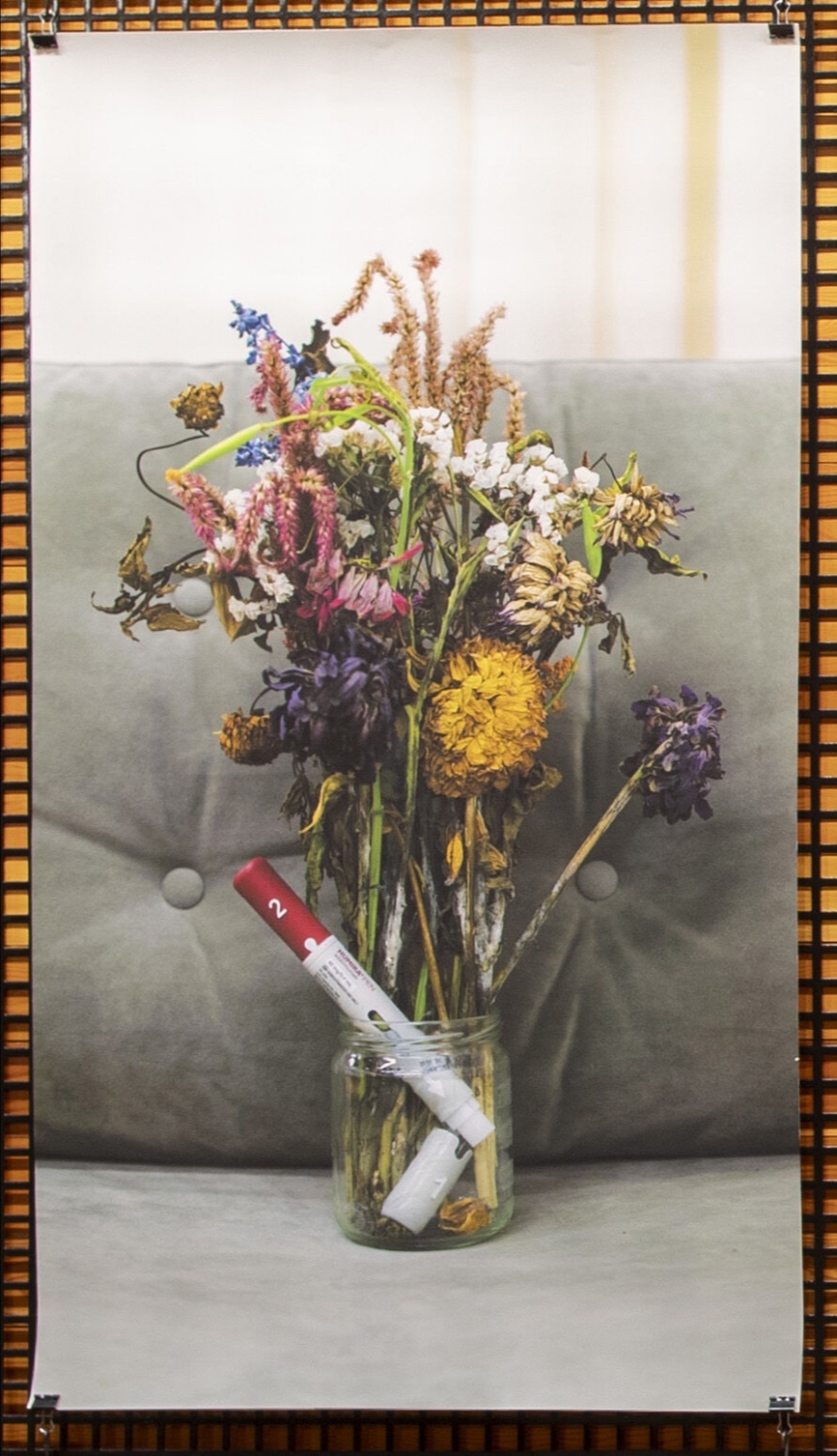
Disability Justice at the Mill City Museum
Published September 25th, 2024 by Benjamin Merritt
'The Art of Disability Justice Now' surveys a wide variety of disabled experiences — the mundane, the sensual, the frustrating, and the deeply interconnected
Banner image: Madison Elyse Rubenstein, Your Survival and Mine Are Intertwined (detail), 2021.
The exhibition The Art of Disability Justice Now, on view through January 5, 2025, at the Mill City Museum, is an expansive array of work that highlights various experiences of disability. The work included in this exhibition ranges from highly abstract to blatantly direct, from the ephemeral to the immensely physical. According to the exhibition statement, the show is "Inspired by the principles of the Disability Justice Movement," the curatorial statement reads, "this exhibition deliberately centers the narratives and leadership of individuals who have historically been most marginalized within the mainstream Disability Rights Movement, including BIPOC, queer, trans, and immigrant disabled people."
The first pieces in this exhibition are two quilts by Emma MacLean, Resting No. 1 and I Am Deserving Of Rest. Both of these quilts play with negative space, with a curled up figure laying in the center of the quilt. In I Am Deserving Of Rest, an abstracted figurative shape filled with flowers sits in the middle of a black sheet, with the title text overlayed on top. Materially, this piece relates to rest in multiple ways — it is a bedsheet with direct relationship to the resting body, and it also requires a lot of work in stitching and quilting this piece.
 Resting No. 1 and I Am Deserving Of Rest by Emma MacLean. Photo by Chris Juhn.
Resting No. 1 and I Am Deserving Of Rest by Emma MacLean. Photo by Chris Juhn.
I’m interested in the way this work evokes a complex notion of rest — in America, rest is not as simple as taking a nap or laying down when you feel you need to. Physical rest can be nearly impossible depending on the physical nature of specific disability, navigating the healthcare system that is supposed to help you is extremely discouraging and difficult for many disabled people (particularly those who have immigrated from other parts of the world and may be withheld services to alleviate these processes), and if your disability is invisible, you may need to constantly advocate for your needs to other people as well as the state to justify your needs in existence. How are these difficulties alleviated? Through community and care networks, as the exhibition points out.
Even something as personal as rest is never solely personal — a core aspect of disability justice is this idea of interconnectedness, that we are all connected all the time, despite what popular Western notions of hyperindividualism and personal responsibility tell us.
 Trista Marie McGovern with their work in the exhibition. Photo by Chris Juhn.
Trista Marie McGovern with their work in the exhibition. Photo by Chris Juhn.
Interconnectedness brings me to the work of Trista Marie McGovern, whose modeling and writing in the exhibition speaks to intimacy and desire. Their writing is beautifully vivid and metaphorical:
“I’ve dismantled the machine to rebuild it correctly, and discarded the parts not useful to me. I’ve translated the twisted ingrained language so I could decipher what’s
real and what’s not. I’ve walked across coals and consoled you for watching.”
As well as extremely blunt:
“People do not, at the core, realize that humans who do not look or function like them are still actually very much like them.”
Trista Marie McGovern’s modeling in the three photos showcases something that is so often left out of the narratives of disability, intimacy, sexuality and desire.
Elsewhere in the exhibition, two painters reflect on embodiment in much different ways. Madison Elyse Rubenstein, whose work I’ve covered before, exhibits Your Survival and Mine Are Intertwined, a thickly textured painting of abstract forms entangled within each other. Knotted up, these forms have no beginning or end separate from one another, a beautiful abstract representation of the deep connection between people. The paint is applied with a piping tool, popping off of the surface. The form that is being entangled in this painting is rendered with multiple different planes of varying colors, treated with different levels of textures and brushwork. The form is dense and bodily, yet there’s a weightlessness in the way the object sits just a few inches away from the bottom of the panel, surrounded by white.
 Madison Elyse Rubenstein, Your Survival and Mine Are Intertwined, 2021. Oil paint, gold leaf, color pencil and graphite on clayboard, 36 x 36”
Madison Elyse Rubenstein, Your Survival and Mine Are Intertwined, 2021. Oil paint, gold leaf, color pencil and graphite on clayboard, 36 x 36”
Next to Rubenstein’s work is a series of acrylic paintings by May Ling Kopecky. Kopecky’s paintings of medical spaces sit in between an anticipatory space and a reflective space. These pieces are rendered with such a deeply felt amount of care — I can feel the rubber ball the nurse asks me to hold in Blood Work, I can smell the sanitary air and non-latex gloves, I feel the cold hand on my forearm as I look away from the needle. If I feel this much as a viewer, I wonder how the process was for Kopecky — painting these environments with such attention and care can have the power to be comforting or harrowingly confrontational. The beauty of these pieces is that they feel both of these ways at the same time, and that’s how these spaces usually feel.
Zoe Cinel’s inkjet photo titled Natura Morta with Adalimubab is a photograph of decaying flowers in a jar alongside a pen of Humira, also known as Adalimubab. This is an injection pen of an immunosuppressive drug that helps treat conditions like arthritis, hidradenitis suppurativa, and Crohn’s disease. The pen, with its cap off, rests in the glass jar alongside the flowers after being used. There are multiple contrasts here between a soft surface that the jar rests on, the hard plastic pen and glass, the organic dying flowers and the sterility of injection.
 Zoe Cinel, Natura Morta and Adalimubab, photograph.
Zoe Cinel, Natura Morta and Adalimubab, photograph.
I spent a few years taking Humira in my late teens. I remember rewarding myself for successfully giving myself an injection — going to the record store afterward, ordering takeout, or renting a movie I’d been wanting to see. It was my way of convincing myself to take the drug, going through the experience of pressing a cold, refrigerated plastic tube against my belly and quickly injecting medicine in, holding it beneath my skin for 10 seconds for the medicine to dissipate.
If someone uses Humira, they likely have to take it every week or two, indefinitely. Cinel’s piece speaks to me about this idea of the futility of reward and the experience of endless treatment, the decaying flowers marking how much time has passed, as another injection passes by.
This exhibition is very rewarding in its ability to evoke so many different feelings, through a multitude of media and scale. The show can be viewed in person at the Mill City Museum until January 5, 2025, and can also be viewed online in their online 3-D tour. ◼︎
 A visitor with the work of Janice Essick (left) and Donna Ray. Photo by Chris Juhn.
A visitor with the work of Janice Essick (left) and Donna Ray. Photo by Chris Juhn.
The Art of Disability Justice Now is on view at the Mill City Museum through January 5, 2025, featuring the work of 14 artists. Gallery hours: Thursday & Friday, 10am – 4pm; Saturday & Sunday, 10am – 5pm. Admission to the exhibit is free.
Banner image ID: Abstract painting of white spaghetti-like coils on top of a multi-colored rock on a thick white background.
We can't do it without you.
Help keep independent arts journalism alive in the Twin Cities.